По всем вопросам обращайтесь на: info@litportal.ru
(©) 2003-2024.
✖
Floyd’s Thai Food
Настройки чтения
Размер шрифта
Высота строк
Поля
For frying oils, use coconut oil for stir-frying, if possible, and good-quality vegetable, corn or sunflower oil for deep-frying.
Thai curries differ dramatically from Indian ones. The Indian kitchen largely uses dried and often toasted spices. The Thai kitchen uses fresh herbs and spices, often toasted, to make a ‘wet’ curry paste. Thai curries can be severely hot, so take care with the chillies, especially the small bird’s eye chillies. These tiny little things are absolute dynamite. As a rule of thumb, the seeds are the hottest part of the chilli and the pith the next hottest, and most chillies are fairly mild if these elements are removed – I leave it to you.
What these pineapples lack in size they make up for in sweetness.
Pounding the spices for a curry paste at the Intercontinental Hotel.
These mixed nuts are sold ready-chopped.
A trader prepares her wares at the Chatuchak Market.
These birds will be despatched for you at the market, or you can do the deed yourself at home.
Let’s put Thai curry paste on the line! Are you blender-lazy or pestle-proud? Traditionally, Thai curry pastes are made with a pestle and mortar. The ingredients are added gradually in the given order, starting from the hardest and the driest to the softest and the wettest, with each being reduced to a pulp before the next is added. As the ingredients are pounded, they release their fragrance and the balance of the paste can be sensed in the aroma and can be adjusted while the paste is being made. My recipes for curry pastes must be used just as a guide. They are not written in stone, it is not gospel and it is not rocket science. Sometimes, for instance, you may find that the shallots or the galangal you are using are sharper than usual, so touch, taste, smell and adjust. Needless to say, making a curry paste by hand is time-consuming, onerous and messy, but the result is genuinely superior – both in texture and balance of flavours – to one made in a food processor. Pastes made by hand have an integrity and intensity of flavour and the loving serenity that no machine can ever equal. However, these days, when everyone seems to lead such busy lives, you’ll probably want to use the food processor.
One of the most agreeable things in fine Thai restaurants is the sight of serene but smiling ladies in traditional costume sitting cross-legged on a bench-cum-table carving fruit and vegetables into exquisite shapes to garnish so many Thai dishes. They spend years acquiring their exquisite art and it is a joy to watch their patient skill. If you have the time and the patience, you may wish to emulate them.
The Thai table and quantities (#ulink_41b99bb5-f3f0-5ef1-9137-af9fb19ecdde)
Eating Thai food (which, by the way, is not served as a procession of starter, vegetable, main course and pudding) is meant to be a sociable affair where all the dishes are presented as they are cooked. Soups come in a large bowl and are eaten throughout the meal, not before it, and, certainly in Thailand, the food is not necessarily served hot. Some food is placed on platters, passed around and eaten with a spoon and fork, not with chopsticks.
For some mad reason, food editors seem to require measurements, weights and cooking times all in precise detail. Now, most food in Thailand, and indeed throughout Asia, is cooked outside on the simplest of equipment by people who have never read a cookery book or watched a TV cookery programme, they just cook instinctively. If you have only a small amount of chicken, then you have only a small amount of chicken, so you stretch the meal with rice or noodles. Please be warned that all the measurements, cooking times and weights in this book are absolutely approximate. No Thai person would ever dream of weighing out 275 g/10 oz of noodles or 225 g/8 oz of rice.
Anyway, that is my lecture over. I hope it has been helpful!
Preparing the ingredients for a curry at the famous Pet-Palo-Huahaheng Duck Restaurant.
These ladies were happy for me to try their food.
Sauces, pastes and dips (#ulink_a0ae76ad-c27b-5999-9bc8-184178625cda)
Sauces, pastes and dips (#ulink_a0ae76ad-c27b-5999-9bc8-184178625cda)
White onions.
Fresh root ginger.
Pet-Palo-Huahaheng Duck Restaurant.
The Thai people like their food hot and some of the world’s hottest chilli peppers are grown in Thailand. So, as you would expect, chillies play an important part in their curry sauces, pastes and dipping sauces.
These sauces and pastes are an indispensable part of Thai cooking, and home-made ones are well worth the effort. Many of the pastes can also be used as marinades, dipping sauces or to flavour a simply cooked bowl of rice or noodles. Chilli sauces are also used in salads.
Regional varieties are found throughout Thailand, but the basic curry pastes combine dry spices and fresh herbs with ginger, garlic, chillies and citrus juice and leaves.
Dipping sauces provide a contrast to the food they’re serve with – cooling dips for hot and spicy dishes, or fiery dips to accompany less highly flavoured food.
Khun Phol Tantasathien, owner of the Spring Restaurant, was great company.
Curry powder (#ulink_0ec51128-c9b5-58cd-8692-b1784dfa4e29)
1 tablespoon cloves
3 tablespoons coriander seeds
3 tablespoons cumin seeds
1 tablespoon fennel seeds
3 tablespoons dried chilli flakes
3 tablespoons turmeric powder
2 tablespoons ground ginger
2 teaspoons white peppercorns
4 cardamom pods
1 Heat a wok or heavy-based frying pan and, without adding any oil, dry-roast the cloves, coriander, cumin and fennel seeds for 40–50 seconds until they release their fragrance, then grind to a powder in a spice grinder.
2 Add the remaining ingredients to the ground spices in the grinder and whiz to a powder. Store in an airtight jar.
Appreciating the shade at the Damnoen-Saduak floating market.
Dry-frying my spices for a curry paste, in the kitchens of the Intercontinental Hotel.
Ingredients for the Thai red curry paste.
The sauces and pastes below are used in recipes throughout the book. The dips, starting on page 51, will all go with kebabs, prawns and finger foods.
Thai green curry paste (#ulink_29602809-9b48-5a36-9ec0-10d9c665a6c5)
1 teaspoon cumin seeds
1 teaspoon coriander seeds
6 fresh green chillies, chopped a handful of finely chopped fresh basil leaves
1 tablespoon chopped fresh lemon grass
1 tablespoon chopped fresh coriander root or coriander leaves and stalks
2 red shallots, peeled and chopped
4 garlic cloves, peeled and chopped
1 cm/








